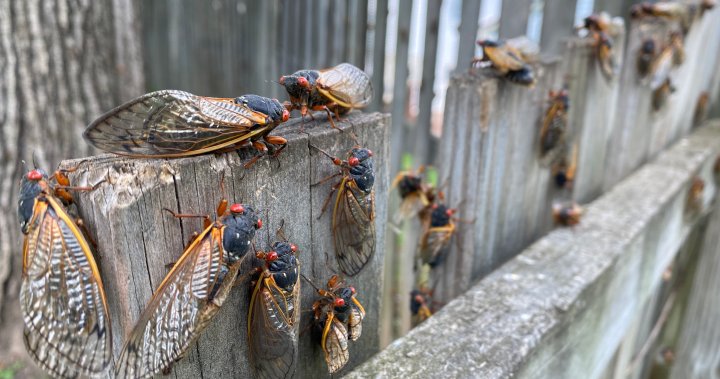In a rare natural phenomenon that has not been witnessed since the 1800s, illions of cicadas are poised to emerge from their decades-long slumber across the eastern half of the United States this spring and early summer.
This double brood event will happen just south of Canada, with both 13-year and 17-year cicadas emerging simultaneously, which has not happened since 1803, when Thomas Jefferson was president. And the next time this will happen will be in 2,245.
“This is a big, big event,” said David Beresford, an entomology professor at Trent University in Oshawa, Ont. “Just like the solar eclipse, the cicada emergence is probably once or twice in a lifetime event that will be able to take advantage of, and I am quite excited.”
He stressed that these insects are harmless to humans and are “actually quite cute. They look like little tree frogs, probably one of the most endearing insects out there.”

The spectacle is set to unfold across the eastern U.S., with its northernmost boundaries extending into Illinois. Although this may be as far north as the event happens, Beresford still hopes it may appear in southern Ontario too, but admitted to speculating and remaining hopeful as an insect enthusiast.
“I hope that we catch the very edge of those and get to see it,” he said. “But it will be worthwhile going to the States to be part of this.”
Cicadas are known for their loud buzzing chorus that fills the air during mating season on warm summer days. There are more than 3,200 species of cicada worldwide, according to the Smithsonian Museum of Natural History. In Canada, Beresford said there are several species but they are “annual cicadas” meaning they may emerge from the ground every season.
In contrast, the rare double-brood event in the U.S. involves periodical cicadas that synchronize their emergence during 13 or 17-year cycles, Beresford said. Periodical cicadas occur in different regional “broods,” each consisting of one or more species with the same cycle length.
Gene Kritsky is a professor of emeritus of biology at Mount St. Joseph University, in Cincinnati, Ohio, and has been eagerly awaiting this event as a devoted fan of cicadas — he even wrote several books about them.
The latest health and medical news
emailed to you every Sunday.
The latest health and medical news
emailed to you every Sunday.
“These periodical cicadas come out in massive numbers once every 17 or 13 years. And so they’re like bugs of history,” he said.
Periodical cicada broods in the United States.
UDSA Forest Service
The impending emergence of cicada broods this spring and summer includes Brood XIII, operating on a 17-year cycle, and Brood XIX, following a 13-year cycle. Spanning parts of 17 states, he said these two broods will overlap in a small region of central Illinois, where the largest amount of these insects will appear.
He estimated the double brood event would produce around billions of cicadas in the region.
The reason these cicadas only appear once every decade or so is because of evolutionary reasons, Kritsky said.
“The goal of all species is to simply reproduce,” he explained. “They do that by their survival mechanism… to combine the massive numbers. Some of the earlier cicadas that come out, they’re going to be consumed by predators. To the point where the predator is satisfied, and then the later ones are the ones they’re going to be reproducing.”
What do cicadas do when they emerge?
When cicadas are underground during these years, they are not hibernating, Kritsky said, they are making tunnels and sucking on tree roots to survive.
When it is the spring of their 13th or 17th year (depending on which brood), he said, they begin emerging from the ground, mainly at night once the soil warms to a certain temperature. At this stage, the nymphs then crawl up any hard surfaces, like tree trunks or fences, and molt into adult winged cicadas.
“I’ve told people that if they if they’re lucky to have this in their backyards, they should go get the kids because these things come out at night or right at sundown,” he said. “So get a flashlight and you can watch this thing climb up and split the exoskeleton. It’s just while it’s like having David Attenborough in your backyard.”

After four or five days, adults fly into the tree canopy, where males start “singing,” he said, and this is to attract a mate. Females then hear this and fly into the tree. The females that are attracted to a particular male’s call respond with wing flicks, which also make a sound. Pairs then mate.
“So you can think of these things almost like a periodical cicadas singles bar,” he joked.
Once they mate, the female cicadas lay their eggs, which take about six to seven weeks to hatch, after which hatched nymphs drop to the ground and burrow to begin the next generation of periodical cicadas. The adult cicadas then eventually die.
What will the double brood event sound like?
According to Kritsky, when you visit a spot where the broods emerge, on a warm, sunny day, the male cicadas’ singing can reach an impressive 90 to 95 decibels.
To put that into perspective, the sound may be loud enough to drown out a jet engine, he said.
“If you have ever gone to a rock concert and when you leave and get in your car and you still feel the sound and vibration in your ears…. well 20 minutes with these cicadas, that’ll do the same,” he said.
To witness this phenomenon, he explained that the cicadas are projected to begin emerging first in the southern regions of the U.S., likely around mid-April.
Periodical cicadas can require 17 years to complete development.
Getty Images
As spring progresses northward, their emergence will extend into May and June, reaching areas closer to Canada. He suggested that if the spring weather remains favourable, Chicago might experience this occurrence around the third week of May, although he emphasized that it’s merely an estimate.
“You should find areas where they’re emerging in northern Illinois, in middle to late May, and you can see the emergence come out,” he said. “And then you drive south about two-and-a-half, three hours. You’re going to be hearing singing. So you could probably experience the whole cicada thing in 48 hours.”
You can also download the Cicada Safari app that allows you to track the broods and report cicada sightings from your location.
— With files from Reuters



